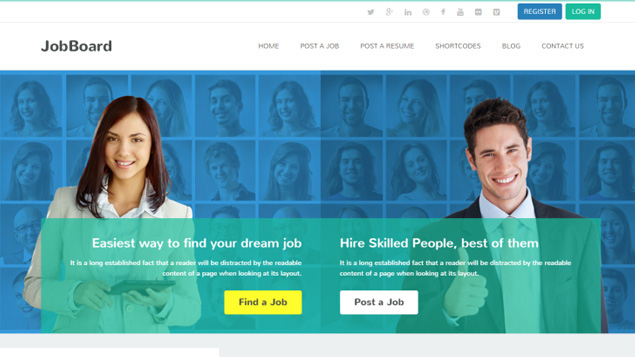Suppose that you are running a recruitment business, the server goes down unexpectedly. Many of your team immediately begin packing up their stuff and heading for the door as if nothing can work without internet access. They say such words as, “We can’t work as there’s no connection”; “There’s no point just sitting around without internet access”. You then suddenly realize that you have a team of recruiters who actually believe that they couldn’t work just because they have temporarily lost their access to the internet?
So there need some practical recruiting tips if for whatever reason you happen to find yourself back to the 90s. But before hitting to the point, let do your homework about recruitment in the 90s and in the social recruiting era.
Recruiting Evolution

Mid-Late 90’s = Desks and Phones
That time, recruiters received paper resumes in the mail, scanned them with OCR software and input them into their internal database. They used some fledgling online resume databases, attended job fairs and posted to online newsgroups. They lived on the phone, cold calling to target firms. Times were really hard for HR recruiters!

Late 90's - Mid 2000's = Job boards
Then came the era that the Internet was booming and there’s a website for everything. Embracing this new technology, recruiters posted jobs on Monster, MonsterTrak, CareerBuilder, etc. They also advertised positions, waited for people to apply online, and scoured the internal database for candidates. It was called the recruitment method of ‘Post-and-Pray’. The so-called proactive recruiters would go out and search the online resume databases and directly reach out to candidates. Of course, all of those candidates (those contacting recruiters and the other way around) were all active jobseekers and, thus, not exactly ideal. Among human resource management, there was round-the-clock talk of reaching the passive jobseekers though, it always sounded more like a faint wish for the future rather an actual action plan. That time, recruiters still attended job fairs, but this made no different in seeking out passive jobseekers. It’s because those job fair attendees were just the same people they were already finding online (i.e. active jobseekers).

For those who are interested in:
“Job rotation” – A cheap and useful recruitment method
4 useful tips for generating candidate resources
Mid – Late 2000’s = Linkedln Dawn and Expansion
Though recruiters that time were still utilizing job boards and resume databases, there was something new horizontally – Linkedln. Linkedln helped recruiter find lots of great passive candidates.
2010 - Onward = Social recruiting era
Presently, it’s all about social recruitment, making connections, riveting your target audience, and expanding your reach. It’s all about social influence, Klout, growing your network, increasing your followers, engaging passive candidates, developing your brand, etc.
Linkedln has grown to be a popular name with over 180 million users globally. It has become the business networking site and vital to recruitment. For recruiters, Linkedln has become the standard, just like job boards in the 2000’s and job fairs in the 90s.
In case you are interested in:
Are job references still reliable?
Facebook, Youtube, Twitter, Pinterest, Google+, FourSquare, Meetup, FourSquare, and other social network are also proving to be invaluable recruitment tool. Those forums have not yet been fully availed by the recruitment community as effective sourcing tools though, they are growing by day.

Now it’s time to explore recruiting tips if you happen to be in recruiting landscape of the 90s.
How to optimize your recruitment if you happen to be in the time without internet access?

1. How many clients will you call?
How would you react if you had to cold call 25 clients daily? Not 5 but 25 clients! For some reasons, these days it would seem like an unconquerable task.
Still, try to do it. And at the end of the day, rather than checking the number of emails you have sent to clients (emails that may just be deleted in a nanosecond), look at how many outbound calls there are in your call log. Indeed, meaningful conversations are much more effective than meaningless emails.

2. Can you work without Linkedln?
Linkedln is indeed an awesome recruiting tool. But before this professional networking phenomenon created, recruiters had to, indeed, ask for candidate and client referrals.
Why not apply ‘Six Degrees of Separation’ theory? That is, anyone in the globe can be connected to any other person through a chain of acquaintances with no more than 5 intermediaries. This theory was first proposed in 1929 by Frigyes Karinthy – a Hungarian writer in a short story called ‘Chains’. So go ahead to ask your favorite clients if they can share the details of their colleagues with you. Also, ask your top candidates who else they may be able to recommend. Good people will be happy to recommend other good people.
3. Why not utilize business cards?

For sure, even if you are a ‘500+’ active Linkedln user, you still have a box of business cards on your desk. Then why don’t you go through those cards, and call some of the numbers and speak to the people behind email addresses? They may even pick up your phone. You may then find yourself having one of the meaningful conversations as mentioned earlier. Imagine if they have a role they want to inform you about.
4. How do you let all your temp candidates know about an assignment without Facebook or Twitter?
If a temp assignment comes up, you can make call after call, explaining every suitable tempt candidates about the role over and over again until someone told you that they can start that job.
You know who your top available tempt candidates are. They actually like hearing from you, from time to time. So don’t just call them about the assignment. Try calling them to see how they are. It’s nice what market intelligence you can get from your contract or tempt manpower.
5. How can you advertise your jobs if you can’t access your job boards?

In case you can’t access the job boards, try refocusing your energy. You can pick your top 5 candidates and do your utmost to get them in front of your existing or prospective clients.
That way, you potentially make a placement without having to checking any ad response?
6. The Internet is down. How can you email your shortlist across to your client?
If you have got a killer shortlist, give your client a call, saving her reading through all your consultant summaries. Otherwise, you can suggest meeting them for a coffee and talking through your top 5 candidates.











Replies to This Discussion